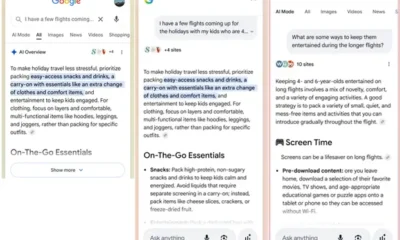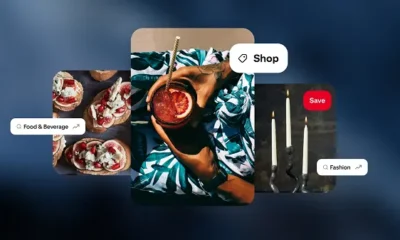SEO
5 Types Of Social Media Networks And The Benefits Of Each One

People use social media to share pictures and videos, post updates, and connect with family, friends, and brands.
Likewise, brands use these social media networks to grow their audiences, conduct target market research, and increase platform engagement.
However, as social media evolves, it can be difficult for brands to determine where to focus their attention. And who has the time to engage on all social media platforms and apps effectively? No one.
So then, which ones should your brand use to connect with its audience? Well, that depends on a couple of factors.
Most brands don’t have the resources or, to be honest, the need to be on all social media platforms, sites, and apps.
In this guide, I’ll discuss the evolution of social media and the top social media networks. I’ll also get into the different brand benefits of each network type.
This will help you strategize where to put your focus, what you want to keep in-house, and areas you might want to outsource.
Evolution Of Social Media
Social media platforms have become an integral part of today’s marketing atmosphere.
They play a significant role in businesses connecting and engaging with current and potential customers.
From sharing information to building relationships, these platforms provide endless opportunities.
When you think of social media, you probably think of the top ones, such as Facebook, Instagram, and Twitter – and you likely lump them together.
But even among these major social media platforms, there are subtypes.
Learning each platform’s different features and potential opportunities can help brands create a more effective social media marketing strategy.
So let’s begin with the old-school platforms. LinkedIn and Facebook (originally Facemash, but who remembers that) launched in 2003.
Twitter followed shortly after that in 2006.
The second wave brought Instagram and Pinterest in 2010. Pinterest’s growth started slow before gaining more traction – today, the platform has over 86 million followers in the U.S. alone
Then, what some consider the first iteration of TikTok – Vine – launched in 2013.
Vine’s surge in popularity was short-lived, as the platform shut down in 2017. But that doesn’t mean we didn’t learn about where people’s attention lies: short-form videos.
Social Media Today
As we see today, social media networks have been competing to keep up with each other and adding more features to keep people on their platforms.
For example, we saw this when Instagram added Instagram Reels to keep up with TikTok.
We also see more platforms, like Twitter, now offering opportunities for its users to go Live.
Now that I’ve covered how platforms compete to evolve and captivate their user’s attention, let’s get into what I mean by a social network.
What Is A Social Network?
A social network is a category or group of a specific type of social media platform or app. There are many types and sub-types of social networks – more than you might think.
I’m sure you’re familiar with specific platforms we’ve already discussed, such as Facebook and Instagram. But what category do these types fall under? And how can your brand best connect with its audience on each?
Next, I’ll break down the following types of social networks and the benefits of each:
- Traditional Social Networks.
- Media Sharing Networks.
- Discussion Networks.
- Social Blogging Networks.
- Review Networks.
1. Traditional Social Networks
- Examples: Facebook, LinkedIn, Twitter.
We talked a lot about traditional social networks, so I won’t go too much more into that type.
But, as I talked about, there are some shifting trends in how brands use traditional social networks.
For example, we can see on LinkedIn and Facebook that people often share articles and long-form posts.
This isn’t to say that short-form posts have gone away; we see short-form posts across all traditional social networks.
We can also see that Facebook has evolved to include more engagement options, such as Facebook Marketplace for shopping, Facebook Live, and Facebook Groups.
The platform also serves as a directory for businesses to create a storefront in the form of a Facebook Page to promote their products, book services, message customers, and leave a space for reviews.
Facebook Pages and Groups are great for brands to engage with their audience and reach new people.
LinkedIn, on the other hand, has been a significant player in online professional networking.
These traditional social networks offer opportunities for brands to use ads to target their audience and conduct market research through Insights and analytics tools.
2. Media Sharing Networks
- Examples: Instagram, Pinterest, TikTok.
There are many forms of visual content across media sharing networks, such as infographics, images, and short-form and long-form videos.
While this network type includes video and picture media sharing, most are now multimedia, utilizing audio, video, and pictures.
On Instagram, there are several main ways brands use the platform: video and image sharing on the brand’s profile, then Instagram Stories, IGTV, and Reels.
People use these sites for entertainment, finding information, and sometimes even shopping. This creates ample opportunities for your brand to reach its audience.
Many products have recently gone viral through TikTok. When people can easily purchase through an app, it gives them a direct way to buy before second-guessing.
Brands also use these sites to disseminate how-tos for their products, collaborate with influencers, promote discounts, and more.
When it comes to Pinterest, you can use numerous marketing strategies to grow your brand on the platform.
Visual content is an engaging way to connect with customers and intrigue them to follow and learn more about your brand – and, eventually, buy your products.
Like with traditional social networks, ads perform well on these platforms, especially when brands use insights and analytics to back their strategies.
3. Discussion Networks
- Examples: Discord, Reddit, Quora.
When people have specific questions or want to discuss a topic, sometimes platforms like Facebook or Instagram aren’t the place to go.
There can be many reasons why people view and create content across platforms.
But when it comes to sites like Discord or Reddit, users are typically there for answers and to connect with communities of people with similar interests.
People also tend to go to these platforms for research.
Discussion Networks allow brands to answer questions and connect with their communities.
Discord alone offers opportunities to create customer community groups, events, and live streams.
Sometimes, hopping into a discussion about your brand or industry can help clarify topics and show you’re willing to engage with your audience.
Your effort to meet your audience where they like to communicate can go a long way in creating long-term customers.
4. Social Blogging Networks
- Examples: Medium, Tumblr, Blog Meets Brand.
When a picture or video isn’t the correct form of content for a particular topic, blogs can be an excellent way to share information with your audience.
Sometimes information is better shared through a blog. For example, it may better explain a subject and help readers understand more complex topics.
Blogs are beneficial for content from thought-leaders. They can expand upon important information or news.
Your brand can also repurpose, expand upon, or share what it creates on its site through social blogging networks.
For newer brands, it’s a great way to develop your voice and build your audience.
These are additional platforms, besides their websites, for brands to share their insights on what matters to them and their target audience.
5. Review Networks
- Examples: Yelp, Glassdoor, Google Business Profile, Trip Advisor.
The most important thing for brands regarding review networks is online reputation management.
Quickly responding to both positive and negative reviews – in a polite and empathetic way – is crucial for retaining a positive online reputation.
Reading online reviews has become essential to the customer journey, and your brand should not ignore them.
Claiming listings across various review networks and creating a plan to manage them can help improve your brand’s image. It can also show potential and current customers how your brand responds to critiques.
It can also provide insight into areas of improvement. As a result, it’s an excellent and sometimes underutilized resource.
Check out these Yelp strategies for inspiration on how to optimize your listing.
Reviews are also a critical part of local SEO since when people search locally, they tend to assess the reviews for the businesses in their area before making a purchase.
People often use a mix of Google and Google Maps to find businesses around them. Optimizing your Google Business Profile for local search is essential for reaching more potential customers.
Final Thoughts
Social media has become an overwhelming but incredibly valuable marketing component for brands.
But categorizing the types of social media networks and identifying which ones your brand wants to engage with can help simplify things.
Then, your brand can allocate the right resources, people, and time to create a social media strategy.
Some brands may outsource components of social media management, such as online reputation management, blog writing, social media post creation, ad creation, and customer service across platforms.
After reviewing your brand’s goals, it will be easier to assess which platforms you’ll put effort towards and which are worth skipping, at least for the time being.
More resources:
Featured Image: Khosro/Shutterstock



















You must be logged in to post a comment Login